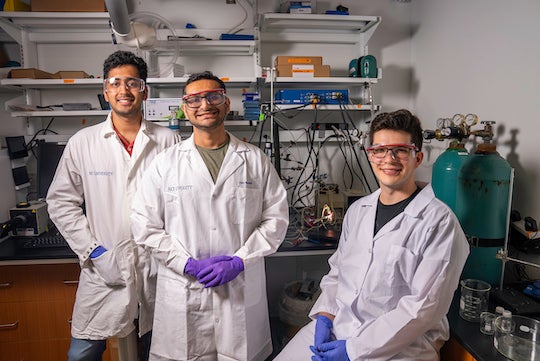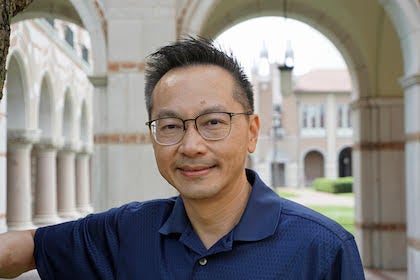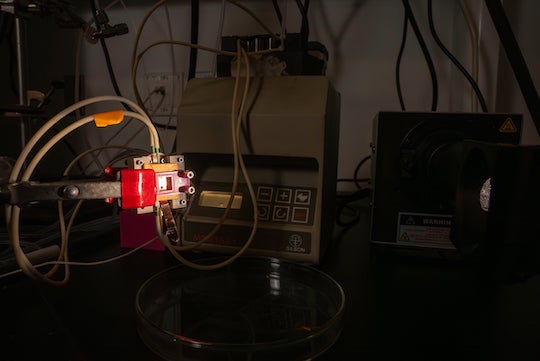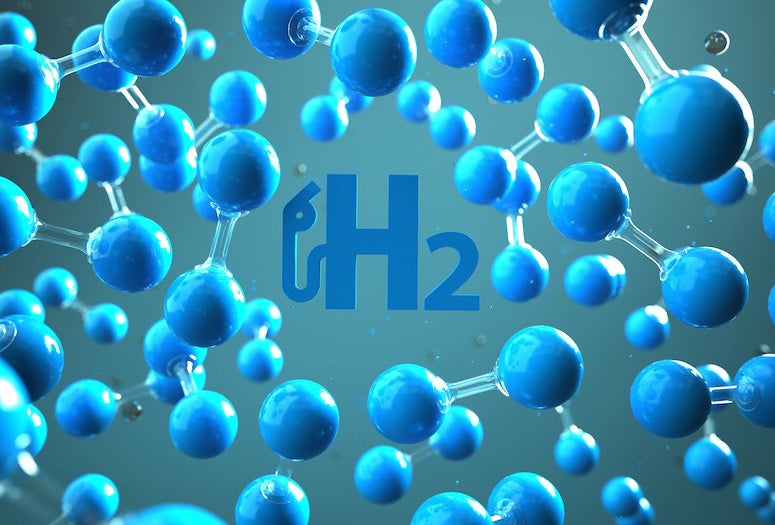Rice University engineers can turn sunlight into hydrogen with record-breaking efficiency thanks to a device that combines next-generation halide perovskite semiconductors with electrocatalysts in a single, durable, cost-effective and scalable device.

The new technology is a significant step forward for clean energy and could serve as a platform for a wide range of chemical reactions that use solar-harvested electricity to convert feedstocks into fuels.
The lab of chemical and biomolecular engineer Aditya Mohite built the integrated photoreactor using an anticorrosion barrier that insulates the semiconductor from water without impeding the transfer of electrons. According to a study published in Nature Communications, the device achieved a 20.8% solar-to-hydrogen conversion efficiency.
“Using sunlight as an energy source to manufacture chemicals is one of the largest hurdles to a clean energy economy,” said Austin Fehr, a chemical and biomolecular engineering doctoral student and one of the study’s lead authors. “Our goal is to build economically feasible platforms that can generate solar-derived fuels. Here, we designed a system that absorbs light and completes electrochemical water-splitting chemistry on its surface.”

The device is known as a photoelectrochemical cell because the absorption of light, its conversion into electricity and the use of the electricity to power a chemical reaction all occur in the same device. Until now, using photoelectrochemical technology to produce green hydrogen was hampered by low efficiencies and the high cost of semiconductors.

“All devices of this type produce green hydrogen using only sunlight and water, but ours is exceptional because it has record-breaking efficiency and it uses a semiconductor that is very cheap,” Fehr said.
The Mohite lab and its collaborators created the device by turning their highly-competitive solar cell into a reactor that could use harvested energy to split water into oxygen and hydrogen. The challenge they had to overcome was that halide perovskites are extremely unstable in water and coatings used to insulate the semiconductors ended up either disrupting their function or damaging them.
“Over the last two years, we’ve gone back and forth trying different materials and techniques,” said Michael Wong, a Rice chemical engineer and co-author on the study.
After lengthy trials failed to yield the desired result, the researchers finally came across a winning solution.

“Our key insight was that you needed two layers to the barrier, one to block the water and one to make good electrical contact between the perovskite layers and the protective layer,” Fehr said. “Our results are the highest efficiency for photoelectrochemical cells without solar concentration, and the best overall for those using halide perovskite semiconductors.
“It is a first for a field that has historically been dominated by prohibitively expensive semiconductors, and may represent a pathway to commercial feasibility for this type of device for the first time ever,” Fehr said.
The researchers showed their barrier design worked for different reactions and with different semiconductors, making it applicable across many systems.
“We hope that such systems will serve as a platform for driving a wide range of electrons to fuel-forming reactions using abundant feedstocks with only sunlight as the energy input,” Mohite said.
“With further improvements to stability and scale, this technology could open up the hydrogen economy and change the way humans make things from fossil fuel to solar fuel,” Fehr added.

Rice graduate students Ayush Agrawal and Faiz Mandani are lead authors on the study alongside Fehr. The work was also authored in part by the National Renewable Energy Laboratory, which is operated by Alliance for Sustainable Energy LLC for the Department of Energy under Contract DE-AC36-08GO28308.
Mohite is an associate professor of chemical and biomolecular engineering and the faculty director of the Rice Engineering Initiative for Energy Transition and Sustainability, or REINVENTS. Wong is the Tina and Sunit Patel Professor in Molecular Nanotechnology, chair and professor of chemical and biomolecular engineering, and a professor of chemistry, materials science and nanotechnology, as well as civil and environmental engineering.
The research was supported by the Department of Energy (DE-EE0008843), SARIN Energy Inc. and Rice’s Shared Equipment Authority.
-30-
- Peer-reviewed paper:
-
“Integrated halide perovskite photoelectrochemical cells with solar-driven water-splitting efficiency of 20.8%” | Nature Communications | DOI: 10.1038/s41467-023-39290-y
Authors: Austin Fehr, Ayush Agrawal, Faiz Mandani, Christian L. Conrad, Qi Jiang, So Yeon Park, Olivia Alley, Bor Li, Siraj Sidhik, Isaac Metcalf, Christopher Botello, James L. Young, Jacky Even, Jean Christophe Blancon, Todd G. Deutsch, Kai Zhu, Steve Albrecht, Francesca Toma, Michael Wong and Aditya Mohite
https://doi.org/10.1038/s41467-023-39290-y - Image Downloads:
-
https://news-network.rice.edu/news/files/2023/07/230713_Austin-Fehr-Ayush-Agrawal-Faiz-Mandani_Gustavo-5.jpg
CAPTION: Ayush Agrawal (from left), Faiz Mandani and Austin Fehr. (Photo by Gustavo Raskosky/Rice University)
https://news-network.rice.edu/news/files/2023/07/230713_Austin-Fehr-Ayush-Agrawal-Faiz-Mandani_Gustavo-.jpg
CAPTION: A photoreactor developed by Rice University’s Mohite research group and collaborators achieved a 20.8% solar-to-hydrogen conversion efficiency. (Photo by Gustavo Raskoksy/Rice University)
https://news-network.rice.edu/news/files/2023/07/photoreactor.jpg
CAPTION: Series of four still images from a sample video showing how a photoreactor from Rice University splits water molecules and generates hydrogen when stimulated by simulated sunlight. (Image courtesy of the Mohite lab/Rice University)
https://news-network.rice.edu/news/files/2023/07/ADITYA_MOHITE.jpg
CAPTION: Aditya Mohite is an associate professor of chemical and biomolecular engineering and the faculty director of the Rice Engineering Initiative for Energy Transition and Sustainability, or REINVENTS. (Photo courtesy of Aditya Mohite/Rice University)
https://news-network.rice.edu/news/files/2023/07/Michael-Wong_LG2.jpg
Michael Wong is Rice University’s Tina and Sunit Patel Professor in Molecular Nanotechnology, chair and professor of chemical and biomolecular engineering, and a professor of chemistry, materials science and nanotechnology, as well as civil and environmental engineering. (Photo courtesy of Michael Wong/Rice University)
- Related stories:
-
Solvent study solves solar cell durability puzzle:
https://news.rice.edu/news/2022/solvent-study-solves-solar-cell-durability-puzzle
Ultrathin solar cells get a boost:
https://news.rice.edu/news/2021/ultrathin-solar-cells-get-boost
Solar energy collectors grown from seeds:
https://news.rice.edu/news/2021/solar-energy-collectors-grown-seeds
Research could dramatically lower the cost of electron sources:
https://news.rice.edu/news/2021/research-could-dramatically-lower-cost-electron-sources - Links:
-
Materials Physics for Energy Management group: http://mpem.rice.edu
Catalysis and Nanomaterials group: https://www.ruf.rice.edu/~wonglab/index.html
Rice Engineering Initiative for Energy Transition and Sustainability: https://reinvents.rice.edu/Rice Chemical and Biomolecular Engineering: https://chbe.rice.edu
George R. Brown School of Engineering: https://engineering.rice.edu
- About Rice:
-
Located on a 300-acre forested campus in Houston, Rice University is consistently ranked among the nation’s top 20 universities by U.S. News & World Report. Rice has highly respected schools of Architecture, Business, Continuing Studies, Engineering, Humanities, Music, Natural Sciences and Social Sciences and is home to the Baker Institute for Public Policy. With 4,552 undergraduates and 3,998 graduate students, Rice’s undergraduate student-to-faculty ratio is just under 6-to-1. Its residential college system builds close-knit communities and lifelong friendships, just one reason why Rice is ranked No. 1 for lots of race/class interaction and No. 4 for quality of life by the Princeton Review. Rice is also rated as a best value among private universities by Kiplinger’s Personal Finance.

